Do you want to pet a German Shepherd puppy and want to learn how to identify its purity? You’re in the right place.
German Shepherd is one of the most popular, intelligent, human-friendly, and demanding dog breeds.
Because of the attraction, human-friendliness, and intelligence people want to pet German Shepherds, but when it comes to identifying its purity they are dubious for various reasons, like Color, Coat, Ears, Back & tail, White spot, and lack of knowledge about the different types of German Shepherd.
This article covers all those important ways through which you can identify the purity of a German Shepherd puppy.
RELATED
- How to Know German Shepherd Puppy is Male or Female | Gender
- Are White German Shepherds Purebred?
- Is There a Mini German Shepherd Breed Exist?
- A Guide for Raising German Shepherd Puppy at Home
- How to Determine the Age of German Shepherd Puppy or Dog
- Are Panda German Shepherds Purebred?
- Male or Female German Shepherd: Which One is Better?
- How to Know German Shepherd Breeder is Genuine?
- How to Determine Most Desirable Traits in German Shepherd?
Topics
- Show Line Vs Working Line German Shepherds
- Showline German Shepherds
- Working Line German Shepherds
- Five Ways to Identify the Purity of German Shepherd Puppy
- Tail & Back
- Color & Coats
- Ears & Mouth
- White Spots
- Dog DNA Test
|| DON’T MISS! Today’s Deals on Chewy – Pet Foods, Products, Supplies, Toys, and more..
Show Line vs Working Line GSDs
Before you go to 5 different ways to identify a German Shepherd puppy section, you must learn the basic differences between the Show Line German Shepherds and Working Line German Shepherds.
Show Line German Shepherds
The Show Line German Shepherds as from their name “Show Line” are used for dog shows. To look excellent, these GSDs have to be perfect in all aspects from teeth to tail.
Show Line GSDs have an angulated back that slopes from high to low as you go from shoulders to rear end.
RELATED
- Slant Back German Shepherds | Types of Showline GSDs
- How Slant (Sloped) Back German Shepherds Were Created?
Working Line German Shepherds
The Working Line German Shepherds have straight back and athletic type of figure, purely built to work all the time tirelessly.
They have bigger heads & bigger bones. Working Line German Shepherds don’t need to be perfect. As clearly evident from their name “Working Line”, always ready for work.
RELATED
- 5 Different Types Of German Shepherd Breeds & Their Features
- Straight Back German Shepherds | Types of Working Line GSDs
5 Ways to Identify the Purity of German Shepherd Puppy
Following are the five ways to identify the purity of the German Shepherd puppy:
- Tail & Back
- Color & Coats
- Ears & Mouth
- White Spots
- Dog DNA Test*
In addition to these ways, you can also identify a German Shepherd puppy from its behavior. German Shepherd puppies tend to be confident and fearless, showing no signs of shyness or aggression. If the puppy seems overly timid or aggressive, it may not be a pure German Shepherd.
Also Read: How to Spot a Fake German Shepherd Puppy | 10 Tips
| Tip: Remember! Buy a German Shepherd puppy that should be at least 35 days old or 40 days old. |
01. Tail & Back
German Shepherds have a long and bushy tail that hangs down.
Show Line German Shepherds have an angulated back that slopes from high to low as you go from shoulders to rear end, but the Working Line German Shepherds backs are less sloped as compared to Show Line German Shepherds.

02. Color & Coat
German Shepherds have distinct coat types that can help in identifying the breed’s purity.
A German Shepherd is a double coat breed, so its coat should be dense and double-layered, consisting of a weather-resistant outer coat and a soft undercoat. They typically have one of three coat variations: short coat, medium coat, or long coat. According to AKC, medium-coat German Shepherds are ideal dogs.
RELATED*
- 4 Types of German Shepherd Coats | Learn How to Differentiate GSD Coats
- German Shepherd Coat Color Patterns and Variations
- 8 Ways to Identify Long Coat German Shepherd Puppy
The most common coat color combinations in German Shepherds are black and tan, black and red, sable, and solid black. The rarer colors like white, blue, panda, or liver also exist, which occur due to recessive genetic traits or mutations. They may not conform to breed standards set by organizations like the AKC, UKC, or FCI.
While coat length and color alone cannot definitively confirm purity, deviations from breed standards, such as a single-layer coat or unusual markings, may indicate crossbreeding.

03. Ears & Mouth
For the first week or two whether it is a German Shepherd’s puppy or some other breed’s puppy, ears remain down. Their ears fully stand up between 4 weeks to 6 months. As a German Shepherd puppy grows its ears droop straight whereas the ears of other breeds droop sideways.
German Shepherd’s puppy mouth is not as wide as the mouths of other breeds are, it is sort of ovally in shape.
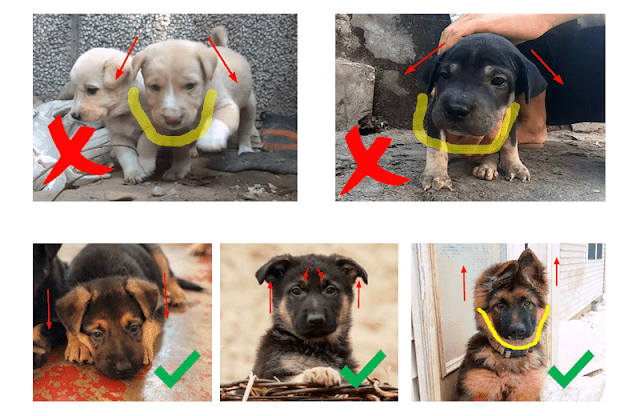
The distance or gap between the ears of German Shepherd is less as compared to other breeds.
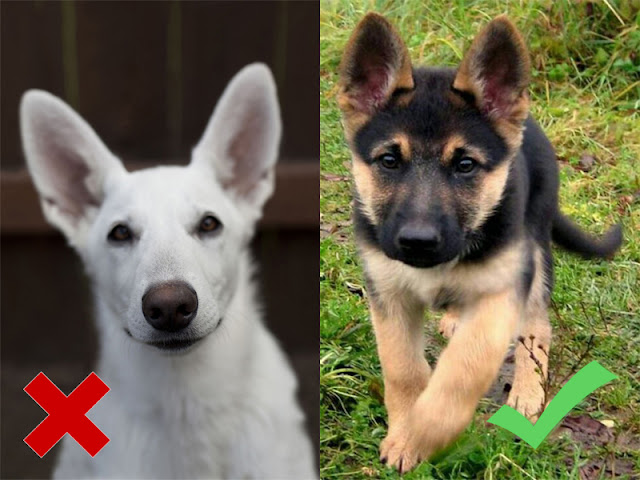
04. White Spots
When it comes to purity checks, the white spots on German Shepherds have always been a debate. There is a general perception among people that the white spot on a German Shepherd makes it impure, so in order to clear this doubt let’s see some cases.
| Why White Spots Occur in German Shepherds? The white spots on German Shepherds are typically caused by residual white spotting genes, which are part of their genetic makeup. These genes affect the distribution of pigment-producing cells (melanocytes) during development, resulting in localized absence of pigment in certain areas, such as the chest, paws, or muzzle. |
Look for any white spot from above on the back, neck, nape, & withers. There shouldn’t be any white spots there, as we have shown in the picture by highlighting that area. You can disagree in this case, but some dog experts are of the view that there can be white spots on any part of its body but shouldn’t be on the back, neck, nape, & withers.
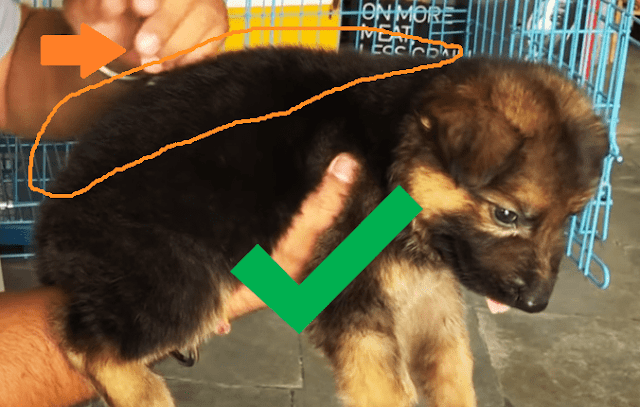
German Shepherd puppies do have white spots on their paws, legs, and upper chest. Always remember that these white spots on paws, legs, and upper chest will not make a German Shepherd impure, it is normal. Some white spots perish naturally as the puppy grows.
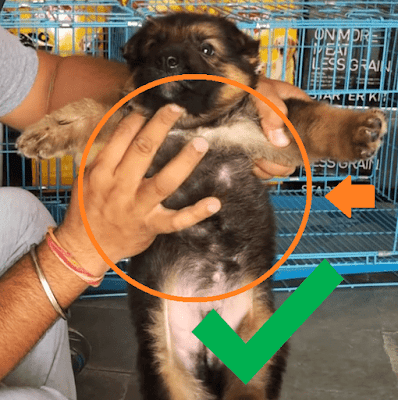
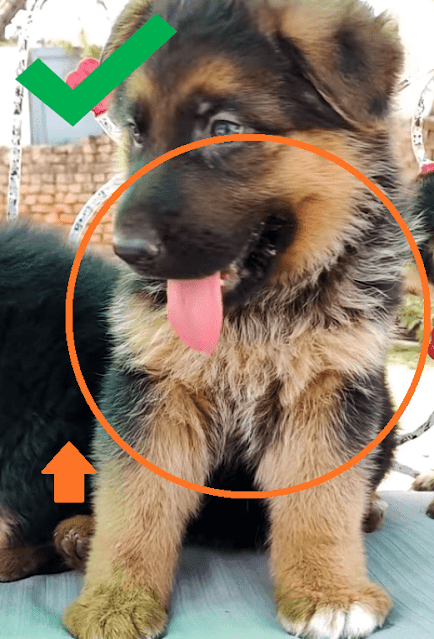
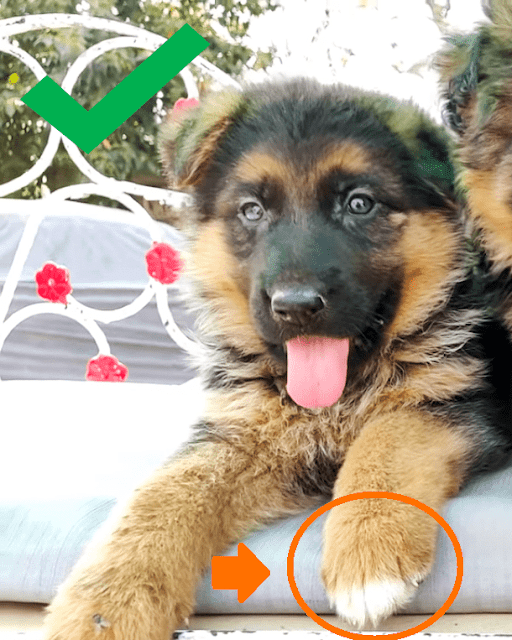
This is the picture of the famous German Shepherd dog Rumor who won the “Best in Show” award at the 2017 Westminster Dog Show. After 30 years a German Shepherd won this title again, and interestingly this dog has a white spot on his chest.
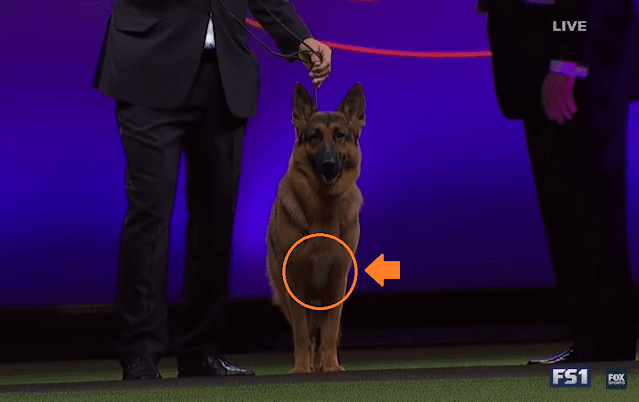
05. Dog DNA Test
If you are a true GSD lover and want to leave no stone unturned regarding German Shepherd’s purity, health condition, ancestry, traits, etc, then go for the Dog DNA test.
Though there are many Dog DNA Test kits in the market, the most reliable and accurate Dog DNA Test kits are Embark & Wisdom Panel.
The Dog DNA test using these kits involves only three steps:
- Collect your dog’s DNA with a quick swab of the cheek
- Activate your test kit
- Mail the sample back to their lab. Normally it takes 2 to 3 weeks for your sample to reach the lab. Once it reaches the lab you get a customized comprehensive online report.
These Dog DNA tests help you to better understand your dog and provide the best possible care, food, training, etc, that it deserves.
To know more about the Dog DNA Test, Read: How To Identify The Purity Of German Shepherd Using Dog DNA Test Kits| Test Results.
It covers the following topics:
- 5 Reasons For Carrying A Quality Dog DNA Test
- How Dog DNA Test Kits Work
- Features Of Embark & Wisdom Panel
- Embark Vs Wisdom Panel – Test Results(which one is better?)
We hope these guidelines will help you to identify the purity of the German Shepherd puppy. If you like this post then don’t forget to share with other people. Share your feedback in the comments section below.
Also Read
- How to Measure the Height & Length of a German Shepherd
- 20+ Best German Shepherd Breeders In The United States
- Mexican Hairless Dog | When People Called Sandra Pineda’s Dog, Statue
- Is White German Shepherd a Good Family Dog?




Leave a Reply